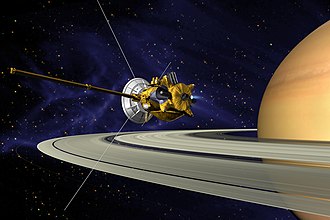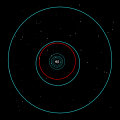Titan (moon)
Titan (Ancient Greek: Τῑτάν)[1] is Saturn's moon. It was found by Christiaan Huygens on 25 March 1655. Titan is a unique moon: it is the Solar System’s only moon to have an atmosphere.
Titan is the largest moon of Saturn and the second largest in the Solar System.[2] Titan is larger than the planet Mercury, but it has less mass. Its equatorial diameter (width at the equator) is 5,150 km.[3][2][4] It orbits 1,221,865 km away from Saturn.[3]
Titan is the only moon known to have an atmosphere and it is thicker than Earth’s. Humans could not breathe it: as it is very cold, and also poisonous. The air is made of nitrogen and methane. Titan is the only place in the Solar System, except Earth, that has lakes and much liquid on its surface. But the liquid is methane, not water.[5][6]
Discovery
Titan was discovered on 25 March 1655 by Christiaan Huygens, an astronomer from the Netherlands. Earlier, in 1610, Galileo Galilei had discovered four of Jupiter's moons. This inspired Huygens: he also wanted to discover new moons. Because Huygens had also improved the telescopes of the time, making them a lot better, he thought he might be able to discover a new moon.
Christiaan and his brother, Constantijn, started to build their own telescopes in 1650. Using the first telescope he ever built, Christiaan Huygens was able to see Titan.[7] At first he called it "Luna Saturni", which means "Saturn's moon" (he did not know there was more than one). Through the years, lots of other moons have been discovered and today the moon is known as "Titan" or as "Saturn VI". The name "Titan", and all the names of Saturn's other moons, are from the Greek legends.
Structure
Titan is the only moon in the Solar System that has a thick atmosphere (the gases that surround a planet or moon).[3] After the spacecraft Voyager I visited the moon on 12 November 1979, it showed that Titan's surface (the ground level) is hidden under an atmosphere that is 900 kilometers thick. Before this, everyone thought that Titan was the biggest moon in the Solar System. Now we know that it is the second biggest, after Ganymede, one of Jupiter's moons.
Even though it is smaller, Titan is close in size to Ganymede. It is also close in size to the slightly smaller Callisto, another of Jupiter's moons. Not only is Titan a big moon, it is even bigger than the planet Mercury, but it only has half as much mass (it is much lighter). Because Titan does not have a lot of mass, scientists think that Titan is made of matter that is not very heavy, specifically frozen water and ammonia. Some scientists think that there is a lot of liquid water and ammonia underneath the surface, enough to fill an entire ocean. These scientists think that there might be a form of life inside this ocean.[8]
At its centre, Titan has a rocky core that is about 3400 km thick. This core is made up of silicates and metals.[9] The gravity (the force that keeps everything attached to the ground) is a lot weaker than here on earth. If you could jump one meter high on the Earth, you would be able to jump seven meters high on Titan.
Movement
It takes Titan 15 days and 22 hours to orbit (travel) around Saturn. This is almost the same time it takes Saturn to rotate or spin around its own axis - one full spin. This is known as "synchronous rotation", which means that the same side of Titan is always pointed to Saturn.
The path in which Titan moves, its orbit, is very close to a circle, but not quite. We use the word "eccentricity" to describe the path that a moon or planet travels in. An image with an eccentricity of 0 (zero) has a path that is a perfect circle. If the eccentricity is more than 0, the path is less round (see image below). Titan's eccentricity is 0.028, very close to zero.
An example of "synchronous rotation": the moon takes the same time to orbit around the planet as the planet takes to spin around its own axis. This means that the same side of the moon is always pointed at the planet and, in this example, people living on the planet will never be able to see the green side of the moon.
Cassini-Huygens mission
On July 1, 2004, the Cassini-Huygens probe entered into orbit around Saturn. On December 25, 2004, the Huygens probe separated from the Cassini probe and started to move towards Titan. It landed on Titan's surface on January 14, 2005. It landed on a dry surface, but it confirmed that large bodies of liquid exist on the moon. The Cassini probe continued to gain data of Titan and a number of the icy moons. It found evidence that the moon Enceladus had water erupting from its geysers.[10] Cassini also proved in July, 2006 that Titan contained hydrocarbon lakes, located near its north pole. In March, 2007, it discovered a large hydrocarbon lake the size of the Caspian Sea near its north pole.[11] The lake of liquid methane has been named Kraken Mare. In 2009, Nasa showed a photograph showing the sunlight reflecting off the surface of the lake. This was the first ever picture of liquid on another world.[12]
In 2012 researchers at NASA discovered that Titan is giving off a faint glow of light.[13] This is believed to be caused by complex chemical reactions occurring in Titan's atmosphere. This kind of light is called an airglow.
Titan (moon) Media
Christiaan Huygens discovered Titan in 1655.
The Huygens probe descends by parachute and lands on Titan on January 14, 2005
Related pages
Further reading
- Lorenz, Ralph; Jacqueline Mitton (May 2002). Lifting Titan's Veil: Exploring the Giant Moon of Saturn. Cambridge University Press. ISBN 0-521-79348-3.
References
- ↑ Morwood J; Taylor J., eds. (2002). Pocket Oxford Classical Greek Dictionary. Oxford University Press. p. 365. ISBN 9780198605126.
- ↑ 2.0 2.1 Cox, Brian; Cohen, Andrew (2010). Wonders of the Solar System. HarperCollins. p. 94-95. ISBN 9780007386901.
- ↑ 3.0 3.1 3.2 Harvey, Samantha (2011-03-04). "NASA: Solar System Exploration: Planets: Saturn: Moons: Titan". NASA. Archived from the original on 2011-03-23. Retrieved 2011-03-13.
- ↑ How it Works Book of Space. Imagine Publishing. 2010. p. 63. ISBN 9781906078829.
- ↑ Stofan, E. R.; et al. (2007). "The lakes of Titan". Nature. 445 (7123): 61–64. doi:10.1038/nature05438. PMID 17203056. S2CID 4370622. Retrieved 2011-03-13.
- ↑ Cox, Brian. "BBC: Science: Space: Solar System: Moons: Titan: Methane rain on Titan". BBC. Archived from the original (Video) on 2011-03-16. Retrieved 2011-03-13.
- ↑ "Telescope by Huygens, Christiaan Huygens, The Hague, 1683 Inv V09196". Boerhaave Museum. Archived from the original on 2007-07-09. Retrieved 2011-03-13.
- ↑ Lunine, J. (21 March 2005). "Comparing the Triad of Great Moons". Astrobiology Magazine. Retrieved 2006-07-20.
- ↑ G. Tobie, O. Grasset, J. I. Lunine, A. Mocquet, C. Sotin (2005). "Titan's internal structure inferred from a coupled thermal-orbital model". Icarus 175 (2): 496–502. doi:10.1016/j.icarus.2004.12.007. [1].
- ↑ Pence, Michael (March 9, 2006). NASA's Cassini Discovers Potential Liquid Water on Enceladus Archived 2008-03-03 at the Wayback Machine. NASA Jet Propulsion Laboratory. Retrieved on July 8, 2007.
- ↑ Rincon, Paul (2007-03-14). "Probe reveals seas on Saturn moon". BBC. Retrieved 2007-07-12.
- ↑ "NASA reveals first-ever photo of liquid on another world". CNN. December 18, 2009. Retrieved 2009-12-20.
- ↑ Wall, Mike (November 1, 2012). "Huge Saturn Moon Titan Glows in the Dark". Scientific American. Retrieved November 6, 2012.














